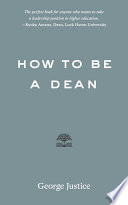

Most ebook files are in PDF format, so you can easily read them using various software such as Foxit Reader or directly on the Google Chrome browser.
Some ebook files are released by publishers in other formats such as .awz, .mobi, .epub, .fb2, etc. You may need to install specific software to read these formats on mobile/PC, such as Calibre.
Please read the tutorial at this link: https://ebookbell.com/faq
We offer FREE conversion to the popular formats you request; however, this may take some time. Therefore, right after payment, please email us, and we will try to provide the service as quickly as possible.
For some exceptional file formats or broken links (if any), please refrain from opening any disputes. Instead, email us first, and we will try to assist within a maximum of 6 hours.
EbookBell Team

4.4
92 reviewsThe essential guide to the hardest job in higher ed.
A deanship in higher education is an exciting but complex job combining technical administration and academic leadership. On one hand, the dean is an institutional leader, standing up for the faculty, staff, and students. On the other, the dean is a middle manager, managing personnel, curriculum, and budgets and trying to live up to the expectations of the governing board, president, and provost. But what is it really like to be a dean?
In How to Be a Dean, George Justice illuminates both of these leadership roles, which interact and even conflict with each other while deans do their best to help faculty members and students. Providing tested advice, Justice takes readers from the job search through the daily work of the dean and, ultimately, to the larger questions of leadership, excellence, and integrity the role provokes. He also explores the roles of "different" deanships in the broader context of academic leadership.
Based on the author's experience as a dean at two large research universities, How to Be a Dean is clear, engaging, and opinionated. Current deans will use this book to reflect on the work they do in productive ways. Faculty members considering administrative work will find in this book some idea about the day-to-day work required of their institutional leaders. And finally, readers who are simply curious about what deans do will find pointed analysis about what works and what doesn't.